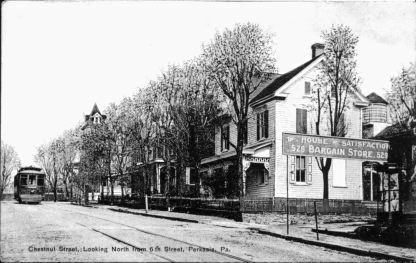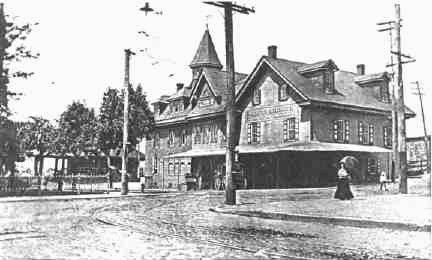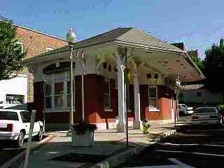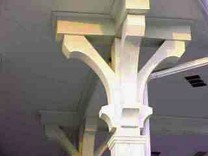 |
|
|
 |
|
|
Trolleys and trains may look similar and serve similar purposes but they were used in different ways in the Perkasie area. Trolleys held fewer people than trains. The trains traveled farther than trolleys. Trolleys completed short trips, (for example from one side of town to the other). There are many people that used the trolley as their everyday transportation in Upper Bucks County. Most people used the train for the longer trips such as going into the city of Philadelphia.
Trolley service began in Perkasie on January 25, 1900 with the first car from the Quakertown Traction Co arrived in Perkasie at 10:00 a.m. A line of the Inland Traction Co from Lansdale was built that year also and the two lines merged in July of that year. One could get on the trolley at almost any point along the route and travel to any town between Philadelphia and Allentown. It would take about three hours to get to Philadelphia on the trolley traveling from Perkasie through Lansdale, North Wales, and Chestnut Hill.
 |
|
|
In the year 1904, 1800 men, women, and children came on the trolley to Perkasie. There were also 1600 cigar manufacturers that came on the trolley also. In 1909 the toll for a round trip from Quakertown to Perkasie was 40 cents. That was a very big deal. There is only one trolley line that ran through Perkasie.
In 1912 the two companies merged and became the Lehigh Valley Transit Co. The freight service of the company contributed significantly to the development of the town (like the railroad).
The Lehigh Valley Transit Company ran a new line through the area. The Liberty Bell Route (serving the towns on the Bethlehem Pike) was to include Perkasie in the new line which brought people to Perkasie on a daily basis. The line was shortened in many places and the route was changed. In 1910 the original line was changed due to derailments from two right angles on 9th Street. The new line ran through Perkasie Park crossing 9th Street on a new overpass and going under the railroad to Walnut Street. This subway (below the train) itself cost $24,000 and the cost of the improvements to the line was $100,000.
The trolley was a very popular transportation method until automobiles got better and safer. Then that is when the trolley system slowed down and they were not used as much any more. It cost $0.20 to travel on the trolley. The prices did go up the longer the trolleys were in use.
Trolleys were a safe transportation method to use unless your were on late at night when few people rode the line. The conductors got a little wild and went as fast as 70 miles per hour. It was very dangerous going around the turns; sometimes the trolley flipped over.
During the 1930's and 1940's the riding habits of the public changed as the automobile came into greater use; automobiles became safer and the quality of roads improved significantly. After a brief revival of riding on the line during WWII, the trolley line declined and the last trolley run was taken in September of 1951.
 |
 |
|
| This is the old trolley station in Perkasie on Walnut Street at Penn Alley. | After the trolley line closed it was used by the American Legion. The building presently serves as the home of the Perkasie Historic Society. |